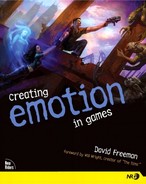Chapter 3.3. Styx[1]
Please take a look
at the two paintings on page 7 in the color section. It's a world of Death and the setting for this chapter's game.
You play a soldier in the Roman empire. You and your best friend Marcus fight a mission together. He's a great guy and a good friend.
But you're fatally injured, and the figure of Death suddenly swoops in toward you. Marcus jumps at him to defend you—and disappears. In effect, he died in your place.
In this fictional game, a number of Emotioneering techniques are at work.
Emotionally Complex Moments and Situations Techniques (Chapter 2.15)
You need to voyage into the realm of Death to try to rescue Marcus. That's the world pictured in these paintings. There you will experience three emotionally complex moments and situations.
When you first enter the realm of Death, you'll be powerless to rescue Marcus. Powerlessness to help someone you care about creates an emotionally complex situation.
When you enter the world of Death, Marcus, now possessed, tries to kill you. If you slaughter him, he has no chance of coming back to life in your world. So you've got to fight him without destroying him. You can only wound him.
Furthermore, the truly emotionally complex portion of this mission is that you'll be torn between being angry at him, as he tries to kill you, and remembering that he's a friend.
NPC Deepening Techniques (Chapter 2.2)
The large eye is Death, but not any form of death character we're familiar with. Death's soul, and his power, is rejuvenated by fear, sorrow, and decomposing flesh.
Death also feels sorrow, however, in that he knows he's missing out on something (life)—but, being Death, he can't really understand what life is. So Death has an unquenchable yearning, but can't even articulate what that yearning is for.
Yearning is an NPC Deepening Technique.
NPC Toward Player Relationship Deepening Techniques (Chapter 2.12)
Once you're in the realm of Death, Death can sense your cares, your passions, your hopes, and your dreams. The dead have none of these. In some ways, Death definitely wants you killed. In other ways, Death doesn't want to kill you, for he longs to possess the kinds of feelings and life force you carry.
You'll battle his henchmen, but he (Death) never quite kills you. (You'll kill many henchmen, though.) Death's goal is to wound you and thus immobilize you, so he can keep you here and “feed” off your emotions.
First-Person Character Arc and First-Person Deepening Techniques (Chapters 2.20 and 2.21)
When you finally face Death in battle, you may have the chance to kill him. (I know that killing death is a strange notion.)
But just as you reach that point, you'll get a glimpse (in a cinematic) of what the world will be like if Death is killed. The world will be totally overrun with people living in abject poverty. It will be a horrible, squalid hell.
Will you kill Death?
Having to take a look at such a “big picture” and take responsibility for all life on Earth is a First-Person Deepening experience. But it also will help you grow in wisdom, which is your Character Arc in this game.
Later, after you rescue Marcus, he'll feel ashamed that he tried to kill you in the realm of Death, even though he was possessed at the time. He'll have a hard time looking you in the face or even being with you.
The only way to restore his feeling that he's worthy of your friendship is to let yourself get in danger, and then let him rescue you.
This is fairly advanced Emotioneering, and I wouldn't make winning the game dependent upon having the player figure this out this difficult “action puzzle” and carry it off. So I'd provide plenty of hints that setting this scheme in motion is a good idea, and let the player get the emotional reward of a friendship reborn with Marcus.
The First-Person Character Arc is the player gaining wisdom. It takes a wise person to solve this emotional puzzle, and when Marcus recovers his feeling of self-worth and the friendship is restored, the player will see the benefit of his or her wise act, reinforcing the wisdom.
Plot Deepening Techniques (Chapter 2.17)
Death had the opportunity to kill you at one point but didn't, because he wanted to vicariously experience your emotions and life force.
You later have the opportunity to kill Death, but you don't, for you come to see that death is necessary.
And so the plot doubles back on itself in an interesting way. A plot that doubles back on itself in an interesting way is a Plot Deepening Technique.
In the beginning of the game, your friend Marcus saves your life in battle.
When you bring him back from the realm of Death, you'll be giving him life. So the plot has doubled back on itself in yet another interesting way.
And it will double back one more time when he saves your life near the end. However, because you staged that event, you were really saving his dignity. Without dignity, man is barely alive. In a metaphoric way, you were saving his life.
So once again the plot has doubled back on itself.
This game case study derives much of its emotion from staging emotionally complicated situations. It's a technique that is under-utilized in many of today's games.
[1] In Greek mythology, Styx is the river across which the souls of the dead are ferried into the underworld.
